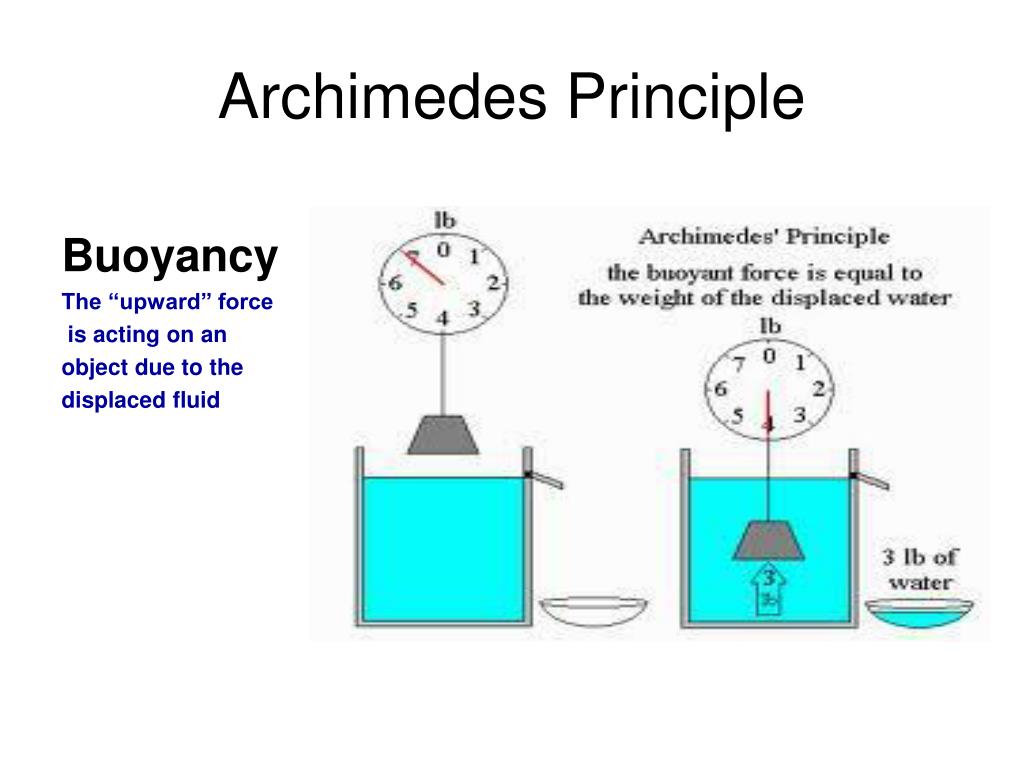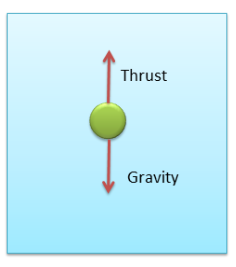

We can think of a water parcel as just a submerged object. You have likely heard of Archimedes’ Law, or Principle, which states that the net upward force on a floating or submerged object is equal to the weight of the water the object displaces. We do this so that we can then understand the effects of density stratification. Interestingly, this method leads to the prediction that the buoyant force exerted on a rectangular block touching the bottom of a container points downward! Indeed, this downward buoyant force has been confirmed experimentally.Now let’s think about the forces due to hydrostatic pressure that can arise when a water parcel is displaced vertically from its equilibrium position.

Lima brings a more general approach for the evaluation of the buoyant force exerted by any fluid (even non-homogeneous) on a body with arbitrary shape. Though the above derivation of Archimedes principle is correct, a recent paper by the Brazilian physicist Fabio M. It is generally easier to lift an object up through the water than it is to pull it out of the water.Īssuming Archimedes' principle to be reformulated as follows,Īpparent immersed weight = weight − weight of displaced fluid Buoyancy reduces the apparent weight of objects that have sunk completely to the sea floor. The force it then exerts on the string from which it hangs would be 10 newtons minus the 3 newtons of buoyancy force: 10 − 3 = 7 newtons. Suppose that when the rock is lowered into water, it displaces water of weight 3 newtons. Suppose a rock's weight is measured as 10 newtons when suspended by a string in a vacuum with gravity acting upon it. Thus, among completely submerged objects with equal masses, objects with greater volume have greater buoyancy. In simple terms, the principle states that the buoyancy force on an object is equal to the weight of the fluid displaced by the object, or the density of the fluid multiplied by the submerged volume times the gravitational acceleration, g. The weight of the displaced fluid is directly proportional to the volume of the displaced fluid (if the surrounding fluid is of uniform density). More tersely: buoyant force = weight of displaced fluid.Īrchimedes' principle does not consider the surface tension (capillarity) acting on the body, but this additional force modifies only the amount of fluid displaced and the spatial distribution of the displacement, so the principle that buoyancy = weight of displaced fluid remains valid. with the clarifications that for a sunken object the volume of displaced fluid is the volume of the object, and for a floating object on a liquid, the weight of the displaced liquid is the weight of the object. a fluid), Archimedes' principle may be stated thus in terms of forces:Īny object, wholly or partially immersed in a fluid, is buoyed up by a force equal to the weight of the fluid displaced by the object For objects, floating and sunken, and in gases as well as liquids (i.e. The ball has certain buoyancy in water, but once ethanol is added (which is less dense than water), it reduces the density of the medium, thus making the ball sink further down (reducing its buoyancy).Īrchimedes' principle is named after Archimedes of Syracuse, who first discovered this law in 212 BC. The Galileo's Ball experiment, showing the different buoyancy of the same object, depending on its surrounding medium. The center of buoyancy of an object is the center of gravity of the displaced volume of fluid.

Examples of buoyancy driven flows include the spontaneous separation of air and water or oil and water. In these cases, the mathematical modelling is altered to apply to continua, but the principles remain the same. īuoyancy also applies to fluid mixtures, and is the most common driving force of convection currents. This can occur only in a non-inertial reference frame, which either has a gravitational field or is accelerating due to a force other than gravity defining a "downward" direction. If the object is less dense than the liquid, the force can keep the object afloat. the displaced fluid.įor this reason, an object whose average density is greater than that of the fluid in which it is submerged tends to sink. The magnitude of the force is proportional to the pressure difference, and (as explained by Archimedes' principle) is equivalent to the weight of the fluid that would otherwise occupy the submerged volume of the object, i.e. The pressure difference results in a net upward force on the object. Similarly, the pressure at the bottom of an object submerged in a fluid is greater than at the top of the object. Thus the pressure at the bottom of a column of fluid is greater than at the top of the column. In a column of fluid, pressure increases with depth as a result of the weight of the overlying fluid. Buoyancy ( / ˈ b ɔɪ ə n s i, ˈ b uː j ə n s i/), or upthrust, is an upward force exerted by a fluid that opposes the weight of a partially or fully immersed object.


 0 kommentar(er)
0 kommentar(er)
